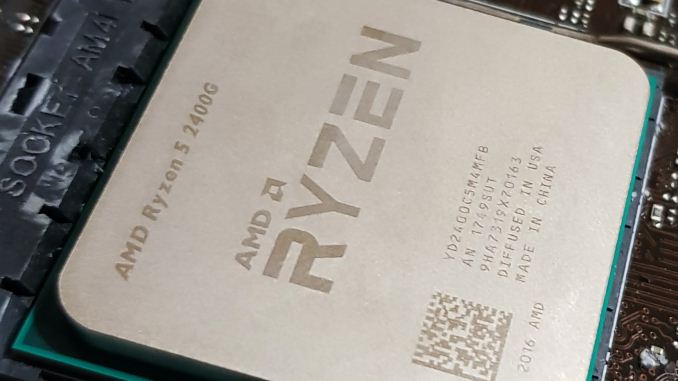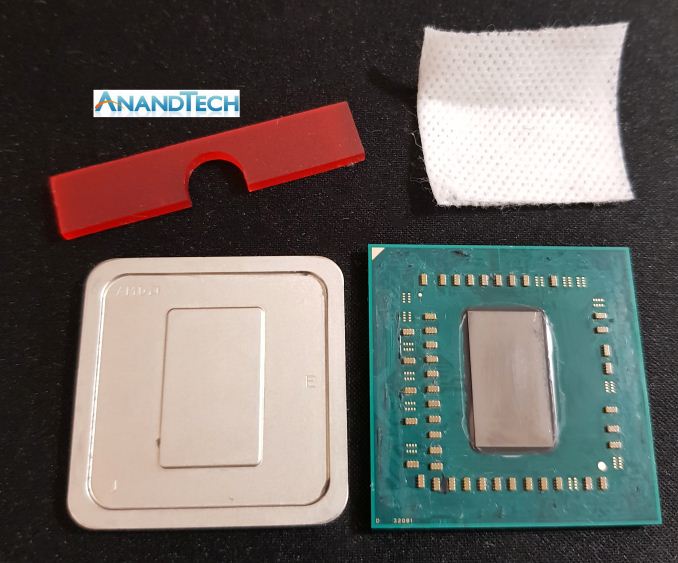AMD Ryzen 5 2400G and Ryzen 3 2200G Core Frequency Scaling: An Analysis
by Gavin Bonshor on June 20, 2018 10:05 AM EST- Posted in
- CPUs
- AMD
- Zen
- APU
- Vega
- Ryzen
- Ryzen 5
- Ryzen 3
- Scaling
- CPU Frequency
- Ryzen 3 2200G
- Ryzen 5 2400G

When AMD launched their first generation Ryzen-based APUs with a Zen cores and Vega graphics, both of the new parts entered the market at two very different budget-focused price points. The Ryzen 3 2200G, sitting at $99 for a quad-core CPU with Vega graphics was an amazing feat, and Ryzen 5 2400G coming in at $169 became the new integrated graphics champion. In our run of performance analysis articles, the question being asked today are relatively simple ones: 'how well do the new AMD Ryzen 2000 series APUs scale with core frequency'? We tested our APUs for standard benchmark performance, discrete gaming performance, and integrated graphics performance.
Core Frequency Scaling on The Ryzen 2000 Series
The perception when overclocking a CPU, or any other component for that matter, is that the increase in clock speed will directly correlate into better performance. The theory is pretty simple on paper, but the translation between the increase of clock rate and increase in performance can be a somewhat different story depending on the rest of the system or how the program is computed.
As a result, a 25% increase in clock speed only really correlates to a 25% jump in performance for the most simple programs, as there are many other limiting factors to consider such as bottlenecks on graphics, memory performance, or stalls in the compute pipeline.
In our testing for this article, we aim to go through and evaluate the differences and performance scaling at different frequencies on our APUs.
| AMD Ryzen 2000-Series APUs | ||
| Ryzen 5 2400G with Vega 11 |
Ryzen 3 2200G with Vega 8 |
|
| CPU Cores/Threads | 4 / 8 | 4 / 4 |
| Base CPU Frequency | 3.6 GHz | 3.5 GHz |
| Turbo CPU Frequency | 3.9 GHz | 3.7 GHz |
| TDP @ Base Frequency | 65 W | 65 W |
| Configurable TDP | 46-65 W | 46-65 W |
| L2 Cache | 512 KB/core | 512 KB/core |
| L3 Cache | 4 MB | 4 MB |
| Graphics | Vega 11 | Vega 8 |
| Compute Units | 11 CUs | 8 CUs |
| Streaming Processors | 704 SPs | 512 SPs |
| Base GPU Frequency | 1250 MHz | 1100 MHz |
| DRAM Support | DDR4-2933 Dual Channel |
DDR4-2933 Dual Channel |
| OPN PIB | YD2400C4FBBOX | YD2200C5FBBOX |
| OPN Tray | YD2400C5M4MFB | YD2200C4M4MFB |
| Price | $169 | $99 |
| Bundled Cooler | AMD Wraith Stealth | AMD Wraith Stealth |
Our previous articles covering the APU performance include a pure overclock analysis, as well as a detailed guide in delidding the processor for extra performance. We have a future article planned on memory performance.

After delidding the processor, for better thermal performance
For the testing, we took each of our APUs from 3.5 GHz to 4.0 GHz on the core frequency in 100 MHz jumps and performed our testing suite throughout. This correlates to a 14.3% performance jump overall, and matches the frequencies we saw in our overclocking articles. At each point we will compare to see if the performance uplift is even loosely correlated to CPU speed.
Test Bed Setup
As per our testing policy, we take a premium category motherboard suitable for the socket, and equip the system with a suitable amount of memory. With this test setup, we are using the BIOS to set the CPU core frequency using the provided straps on the MSI B350I Pro AC motherboard. The memory is set to the maximum supported frequency of DDR4-2933 with CAS latency timings of 18-18-18 within the BIOS to provide consistency throughout the different frequencies tested.
| Test Setup | |||
| Processors | AMD Ryzen 3 2200G | AMD Ryzen 5 2400G | |
| Motherboard | MSI B350I Pro AC | ||
| Cooling | Thermaltake Floe Riing RGB 360 | ||
| Power Supply | Thermaltake Toughpower Grand 1200 W Gold PSU | ||
| Memory | G.Skill Ripjaws V DDR4-3600 17-18-18 2x8 GB 1.35 V |
||
| Integrated GPU | Vega 8 1100 MHz |
Vega 11 1250 MHz |
|
| Discrete GPU | ASUS GTX 1060 Strix 1620 MHz Base, 1847 MHz Boost |
||
| Hard Drive | Crucial MX300 1 TB | ||
| Case | Open Test Bed | ||
| Operating System | Windows 10 Pro | ||
We must thank the following companies for kindly providing hardware for our multiple test beds.
Thank you to Crucial for providing us with MX300 SSDs. Crucial stepped up to the plate as our benchmark list grows larger with newer benchmarks and titles, and the 1TB MX300 units are strong performers. Based on Marvell's 88SS1074 controller and using Micron's 384Gbit 32-layer 3D TLC NAND, these are 7mm high, 2.5-inch drives rated for 92K random read IOPS and 530/510 MB/s sequential read and write speeds.
The 1TB models we are using here support TCG Opal 2.0 and IEEE-1667 (eDrive) encryption and have a 360TB rated endurance with a three-year warranty.
Further Reading: AnandTech's Crucial MX300 (750 GB) Review











29 Comments
View All Comments
eastcoast_pete - Wednesday, June 20, 2018 - link
Gavin, if I read this analysis correctly, this expands on your previous article on CPU core scaling of the 2200G and 2400G, both delidded, but not on iGPU overclocking. Since all graphs are in the 3.5 -4 Ghz range, I assume that this is all for CPU speeds, including the IGPU labeled data. If I am wrong, please correct me, but if you managed to overclock the VEGA cores to 4 GHz, it would be quite a feat!I have a couple of questions:
1. Power and thermals in the various use scenarios? Maybe not for all of them, but some cornerstones to get an idea; if you used the data from the first article, please mention or link to that.
2. What about selective overclocking of the iGPU, especially iGPU only? The key attraction of delidding the 2200 and 2400 for me is a potential to boost the iGPU performance. The stock speed of the CPU is fine IMO.
3. Any information or planned follow-up on undervolting/underclocking the CPU, and boosting iGPU using the stock cooler? If possible, both before and after delidding.
The last question relates to another article here on the best gaming CPUs. Now, some of us can afford a $2000+ rig - and power to them. However, the big challenge really is at the other end. The value king of the "best CPU.." in the $ 500 and under group, the 2200G (or 2400G, if you have a PSU and a disk that can be reused for the new build), really have the much better iGPU going for them vs. price-matched Intels. So, any data on iGPU overclocking coming up? I believe I am not the only one waiting - Thanks!
gavbon - Wednesday, June 20, 2018 - link
Hey Pete, it's essentially following on, with memory scaling also not far off being published (near future depending on schedules etc). I'm actually setting the test bench back up to finish the iGPU scaling piece off which I intend to answer a lot of questions asked from the overclocking piece.To answer your questions directly:
1. Power wasn't much of a factor in this piece as the focus is primarily on CPU frequency scaling, with power consumption being touched upon on in the previous articles.
2. iGPU scaling piece is being worked upon currently, with the test bench being set up tomorrow or Friday (just working on some motherboard reviews today as well as balancing a severe hand injury which has hindered me for the last few weeks).
3. I didn't have a planned follow up planned with a stock cooler, as my aim was to essentially show scaling without much limitations on things like cooling; the stock cooler would obviously generate more heat and I didn't want that to be a limiting factor at any stage.
4. I made a post on my personal Facebook page about Ian's Best Gaming CPU Q2 article just published. My first reaction was the $500 system with the Ryzen 5 2400G made me smile inside as I genuinely think the 2400G is a stunner for the price, especially for gamers on a budget with certain limitations.
The crux is, iGPU scaling is coming, sit tight :D
eastcoast_pete - Wednesday, June 20, 2018 - link
Hi Gavin, thanks for your response! Firstly, sorry to hear about your hand injury, and wishes for a speedy recovery.Look forward to your iGPU overclocking review. If you can, please try it also while undervolting the CPU, so more thermal headroom is available for the GPU.
gavbon - Wednesday, June 20, 2018 - link
I try my best! I fell on a glass and needed 2 and a half hours in surgery to re-attach the tendon in my index finger; was completely severed! - Really appreciate your well wishes! It's on the list, it will be mentioned, don't worry :DSpunjji - Friday, June 22, 2018 - link
Ouch! Heal up well! :)MrSpadge - Wednesday, June 20, 2018 - link
Gavin, I think you should also show the negative scaling in the summary, instead of setting it at 0.00%. What happens is probably that the CPU is eating more into the iGPU power budget at higher clocks, so the average iGPU frequency is reduced.eastcoast_pete - Wednesday, June 20, 2018 - link
Good point. A lot of the iGPU data here really suggest that the performance in a number (all?) games is mostly or entirely GPU-limited, so the 11CU 2400 is always a bit ahead of thr 8CU 2200. Plus, your point on iGPU throttling due to the overclocked CPU cores using up thermal headroom is born out in some of the data, where frame rates show a slight drop at maximum CPU speed.lightningz71 - Wednesday, June 20, 2018 - link
I am still hoping for an article that looks at bclk (base/bus clock) overclocking with the 2200g/2400g. I still think that optimum performance can be had from them by getting the iGPU just past the clock hole between 1300-1500Mhz, then overclocking the ram to 3200-3333 Mxfr, and then nudging the bclk up as high as it can go without causing instability or turning off turbo boost.Lolimaster - Friday, June 22, 2018 - link
Best combo:2400G turbo disabled
3200 CL14
1500Mhz+ igpu
Undervolt cpu (just the cpu part) as this APU's lets you undervolt cpu and gpu independently.
CM Hypeer 212 EVO/X is more than enough for the system, even better if delidded.
Delid+metal just to get good temps with the OCed igpu
boozed - Wednesday, June 20, 2018 - link
WinRAR: "it would seem that other factors came into play with the 2200G"Okay... so what are they?